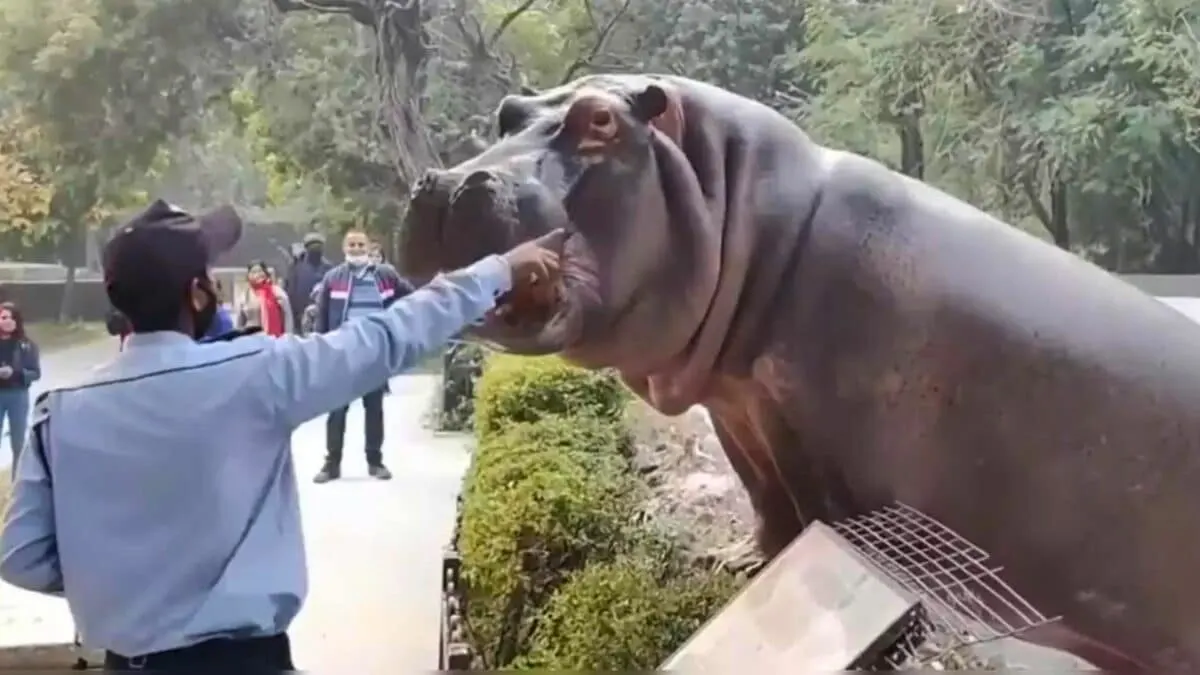Like in the Animated film ‘Madagascar,’ this article takes us through the crazy world of zoos. Let’s watch this real-life story of a Security Guard Preventing a Giant Hippo from Escaping the Delhi Zoo.

Giant Hippo Escaping the Zoo
In this viral video that has taken the internet by storm, we witness a thrilling incident at the Delhi Zoo as a hippo manages to escape its enclosure.
The dramatic footage captures the moment a security guard takes swift action to return the wayward hippo to its habitat safely.
This remarkable event raises questions about the nature of hippos and the challenges of keeping animals in zoos.
In this article, we will delve into intriguing facts about hippos, explore the advantages and disadvantages of zoo environments, and share some fun and educational tidbits about these massive, water-loving mammals.
The Video
Fascinating Facts About Hippos
Before we dive into the discussion on zoo enclosures, let’s learn some captivating facts about hippos:
Aquatic Giants: Hippos are the third-largest land mammals on Earth, following elephants and white rhinoceroses. Surprisingly, despite their enormous size, they are excellent swimmers and spend a significant amount of time in the water.
Night Owls: Hippos are primarily nocturnal creatures, often leaving the water to graze on land during the cooler nighttime hours. Their sensitive skin requires protection from the sun, and they rely on mud and water to shield themselves from harmful UV rays.
Territorial and Aggressive: These seemingly docile herbivores can be pretty territorial and aggressive, especially when defending their territory or young. They are responsible for more human fatalities in Africa than any other large animal.
Zoos – Good or Bad?
Zoos offer several advantages, including their pivotal role in conservation efforts, the educational opportunities they provide, their contribution to scientific research, and their capacity to engage the public in wildlife conservation. They also conduct breeding programs for endangered species, helping to maintain genetic diversity and prevent extinctions.
However, zoos have their disadvantages. Space limitations in many facilities can lead to restricted living conditions, potentially causing stress and health issues for the animals. Ethical concerns surrounding captivity and animal welfare continue to be a point of contention, as some view it as an infringement on the natural freedom and well-being of animals.
Furthermore, there are ongoing debates about the effectiveness of zoos in conservation, with some arguing that resources could be better allocated to protecting animals in their natural habitats. The occasional zoo incidents, such as animal escapes, pose risks to animals and the visiting public, necessitating increased safety measures.
It’s giving: Madagascar
Much like the whimsical adventures of Alex the lion, Marty the zebra, Melman the giraffe, and Gloria the hippo in the animated movie “Madagascar,” the real-life experiences of animals in zoos and sanctuaries can be both enchanting and thought-provoking.
While the film takes a comical and imaginative approach to these characters’ escape from captivity and their escapades in the wild, it does touch upon the essence of animal freedom and their innate desire for a more natural environment.
Just as in “Madagascar,” the realities of zoo and sanctuary life are rich with complex narratives, highlighting the importance of conservation, ethical considerations, and the need to balance our fascination with animals with their welfare and protection.
Fun and Educational Hippo Facts
Let’s conclude with a few fun and educational facts about hippos:
- Speedy Swimmers: Despite their large size, hippos are surprisingly agile in water, moving quickly by pushing off from the riverbed or lake bottom. This method allows them to navigate swiftly in their aquatic environments, which is crucial for escaping predators and covering large areas within their habitat.
- Unique “Sunscreen”: Hippos produce a reddish, oily secretion that acts as a natural sunscreen and skin moisturizer. This substance, sometimes called “blood sweat,” also has antimicrobial properties, protecting the skin from infections.
- Close Relatives: Hippos may appear more similar to pigs or other hoofed animals, but they are more closely related to whales and dolphins. These marine mammals share a common ancestor with hippos, explaining their semi-aquatic behavior.
Conclusion
The daring escape of the hippo at Delhi Zoo reminds us of the complexities and challenges of maintaining animals in captivity. Hippos, with their intriguing aquatic lifestyle and territorial nature, offer us valuable insights into the world of wildlife.
While zoos continue to contribute to conservation and education efforts, ethical concerns and animal welfare considerations remain critical factors. By striking a balance between these facets and ensuring the well-being of animals in captivity, we can continue to appreciate the wonders of the animal kingdom while respecting their natural needs and behaviors.
- Mom and Daughter Takes Hen and Chicks to the Store in Backpacks - April 24, 2024
- Watch: German Shepherd thinks he’s dying at the grooming salon - April 24, 2024
- Watch: Cats Meet Babies for the First Time - April 24, 2024




PrincessPanda
Tuesday 7th of November 2023
I don't think the writer of this article did her research very well. Hippo's are the opposite of "excellent swimmers" because they can't swim at all or even float for that matter. Hippo's move through the water by traveling across the bottom or by pushing themselves up from the bottom and bounding forward.
Felicia
Tuesday 7th of November 2023
Did they build a higher and more secure wall?
Tae
Monday 6th of November 2023
That little tap on the snoot is not doing that big guy any harm. If the hippo wanted, he could have snapped that guard in half. Animals communicate through bites, swats, lunges, and demonstrations of intent; The guard is communicating in a way the hippo understands without causing pain or damage. The reaction of the hippo is more in line with a child who has been lightly admonished in play. Before people start with the rage, look at the body language and try to remember the size/power difference. If that animal didn't want to tolerate it, they would charged, or grabbed the offending hand and taken it off. There's a difference between abuse and communication. Working with companion animals that can be hurt by a swat is not the same as a couple tons of crocodile killer.